Improving productivity of coffee gardens
In a given situation, the productivity of a coffee garden may be limited by the high age of the coffee trees, poor coffee husbandry practices or neglected soil fertility management. In either a new coffee garden or an existing one, different strategies can be adopted to improve the coffee yields.
Establishing a new coffee garden
A coffee garden can be improved by establishing a new garden. Improving an existing coffee garden will give much quicker yields, whereas establishing a new garden will ensure more uniform and better yields.
Establishing a new coffee garden is a good idea when introducing new coffee varieties into an area, expanding coffee acreage or when the old garden is heavily infested with pests or diseases.
However, a new garden may be established at the same site after removing the old one, as long as there are no pest or disease threats from the old crop. An old coffee site will have numerous coffee tree stumps, which are very cumbersome to remove. It is better to cut them close to the ground and cover them with soil to prevent regermination. The entire root system will eventually rot.
If a new site is chosen for establishing a new coffee garden, it should have deep soils that are free-draining. The land should be prepared early so that planting can be done at the onset of the major rains.
Land preparation
Recommendations to farmers for proper planting of coffee without intercrops:
- Prepare the land well when planting coffee to enable rapid establishment of young coffee seedlings. In case of a new site, plough or dig deeply to remove any noxious weeds like kikuyu grass or couch grass. This will make the soil soft so that the young coffee roots can penetrate easily up to the deeper soil layers.
- Remove some tree stumps and roots to allow the proper size planting holes to be dug out. If the land has steep slopes, make terraces to control soil erosion. Grass such as Bahia grass (Paspulum notatum) should be planted along terraces in order to make them stable.
- The appropriate spacing of coffee trees depends on the type of coffee. Recommended spacing for Arabica coffee is about 2.4 metres by 2.4 metres. Spacing for Robusta coffee is about 3 metres by 3 metres, as it makes bigger trees.
Arrangement of trees
In the young fields of coffee, the uncovered space between the seedlings can be used for growing short-term crops (e.g. beans, maize or cassava) for 1 or 2 seasons, or long-term crops like bananas and vanilla. Proper spacing is needed to ensure that the extra plants do not compete with the coffee plants. For example, banana trees can be planted as temporary shade at a spacing of 6 metres by 6 metres, resulting in one banana tree for every 4 coffee trees. The bananas should be pruned regularly and thinned in order to maintain the required shade for the growing coffee.
A row of shade trees can also be planted in every 4 rows of coffee trees or around the edges of the coffee plantation, at a spacing of 13.5 metres by 13.5 metres.
In the coffee agroforestry (without annual intercrops), shade trees should be established at least one year before planting coffee at a closer spacing. The density of the shade trees varies with the type of coffee. In the Arabica coffee system, the density of shade trees is lower than in the Robusta coffee system. Shade trees should be planted at a spacing of about 8 metres by 8 metres in Arabica coffee fields and about 6.5 metres by 6.5 metres in Robusta coffee fields (a row of shade trees should be planted in every 4 rows of coffee). In cases of newly opened land, many trees can be left when clearing the land to provide the required shade.
Coffee agroforestry (multistorey) system
A coffee garden should be established in a mixture of tall and short crops to form a multistorey system. Multistorey means that there are different layers of plants growing to different heights in the system. Three levels (storeys) are important in a coffee agroforestry garden:
a. Crops of the upper storey (shade)
Shade trees protect coffee plants against strong sunlight, contribute to prevention of soil erosion and increase humidity in the coffee garden. Common tree species that can be used as shade trees in both Arabica and Robusta coffee systems include Grevelia robusta, Ficus natalensis, Albizia coriaria, Mesiopsis eminii, Cordial africana, Acacia or Erythrina spp. Fruit trees such as mango, avocado or jackfruit can also be included at intervals.
Desirable characteristics of shade tree species:
- Wind resistant - The species should have a deep rooting system that adds stability to withstand strong winds.
- Small open crown/canopy – This allows for partial shading of coffee trees, allowing shade of about 50 %.
- Quick growing - The species should have quicker growth than coffee so as to provide the required shade.
- Nitrogen fixing - Trees provide nitrogen to the cropping system through nitrogen-rich leaves and roots.
b. Crops of the middle storey
Depending on the needs of the farmer, fruit trees (e.g. citrus, paw paws or bananas) can be integrated as middle storey crops. However, these should be included at a much wider spacing since coffee itself feeds at this level. Multipurpose leguminous trees can also be planted within the coffee garden or along the boundaries (e.g. Leucaena diversifola, Calliandra calothyrsus, Sesbania sesban and Gliricidia sepium). They fix nitrogen into the soil and also provide mulch for the coffee field when pruned. These shrubs are better managed as the middle storey crops through continuous pruning to provide mulching material.
c. Crops of the understorey
The understorey will comprise the annual crops that will be intercropped with coffee during early growth. As coffee trees grow bigger, the ground cover will then be replaced with green manure legumes. Legume ground covers are preferred as understorey crops, for example jack bean (Canavalia ensiformis) or Lablab (Lablab purpureus). Any other perennial non-climbing species can also be used, but they should be regularly pruned. They should be sown at the point of establishing new gardens or when the shading trees and coffee bushes are trimmed in order to allow for enough light for their growth.
Discussion on the establishment of a coffee agroforestry system
Inquire whether the farmers are aware of the potential of intercropping coffee with other crops and trees and about the resulting requirements for management, by asking the following questions:
- Which types of crops and trees are suitable to grow with coffee?
- How should these crops and trees be managed within the coffee garden?
- How do these other trees and crops benefit the coffee and the farmer?
Planting
The coffee seedlings should be planted at the onset of the rainy season into holes, 2 feet by 2 feet large. Ideally the holes are filled with topsoil mixed with 1 bucket/basin of well-prepared manure or compost before planting. A small shade around each young plant protects it from drought stress. In the first year during the dry season the young coffee plants should be watered regularly. Ring mulching keeps the soil around the trees moist.
Training
Proper training of coffee seedlings is important to ensure adequate tree size for easy management as well as to encourage additional branching for maximum production. When coffee has reached a height of about 2 to 3 feet above the ground, it should be bent and pegged onto the ground. This allows for the formation of more stems, thus increasing the yield potential of the tree.
After establishing a good coffee garden, it should be well-maintained in order to ensure good yields. The same management practices applied to an existing coffee garden should be implemented on an on-going basis.
Improving an existing coffee garden
An unproductive coffee garden can be brought back into production. The applicability of rehabilitation depends on the status of the coffee garden. Improving an existing coffee garden only makes sense if the garden is not infested with pests or diseases and when the farmer wants to protect and multiply the existing varieties.
Discussion on improving an existing coffee garden
Inquire among the farmers how they normally improve unproductive coffee gardens. Do they cut them down to establish new ones or just abandon them? Get ideas on the common practices and introduce the following guidelines.
Gap filling
Yield depends, first, on the proper plant population in the coffee garden. If some trees died off or were destroyed by wind or disease, they should be replaced to ensure optimum yields. In case the gaps were created due to coffee wilt disease, remaining plant material should be burnt to stop it from spreading to other coffee trees. The gap should then be used for planting a shade or fruit tree.
Pruning of coffee
Coffee pruning is very important to rejuvenate old coffee trees. Removal of unproductive branches and stems promotes building of new stems.
Recommendations to farmers regarding proper pruning of coffee:
- Pruning should be done at the end of the main crop harvest, before the trees start flowering again. Pruning should be done in 4 stages:
- Main pruning - This is where the number and spacing of primary branches is regulated. The number of stems on each tree should be limited to a maximum of 3 to 4 in number. A higher number will result in lower productivity due to increased competition for nutrients and light.
- Tipping - This is the removal of the growing tip at a height of about 7 feet to keep the base of the tree stronger and to facilitate picking at harvest time.
- Secondary pruning - Coffee beans are produced on the lateral branches. Each lateral branch should bare two crops and then be pruned. This will encourage new lateral branches higher up the tree each year. It is also important to remove most of the inside laterals to let light into the coffee canopy to promote ripening of the berries and encourage rapid drying of the leaves to reduce risk of fungal infections. Secondary branching of laterals should also be removed.
- Sucker control - This is the removal of unwanted growing shoots called ‘suckers’. This should be done continuously, several times a year. The selection of some ‘suckers’ to grow into new bearing stems should be done every 4 to 6 years. Therefore, leave well positioned ones that will replace the original stems.
Stumping is recommended for all old long and unproductive stems in order to encourage fresh, stronger and more productive stems. A pruning saw is the most effective tool for pruning. It leaves a ‘clean cut’ and allows the plant to recuperate faster than if pruning was carried out with a machete.
Improving soil fertility
Growth and yields of coffee are highly dependent on fertile soil. There are two approaches to building a fertile soil in the coffee garden. The first approach is to prevent soil and organic matter loss. The second is to grow crops that feed the soil or directly add organic manures, compost and other organic amendments to improve the soil organic matter content and nutrients.
Discussion on improving soil fertility in coffee gardens
Ask the farmers which organic materials are commonly added to coffee gardens to improve soil fertility.
Soil conservation
Soil erosion is normally a problem whenever production takes place on the hill slopes. This is particularly common in the Arabica coffee system, although it happens in the Robusta system as well. Whenever the land is sloping, water will flow downwards taking with it topsoil and organic materials. This implies that the most nutrient-packed part of the soil is lost. To avoid soil erosion, common soil conservation measures must be adopted. This includes digging trenches in the form of contour bands across the slope to collect topsoil and rainwater. These can be further strengthened by planting grasses and tree shrubs along the contour bands. Mulching also helps to reduce the speed of runoff rainwater.
Improving soil organic matter content and nutrients
Organic materials and mulching
- Organic materials such as plant materials, compost or animal manures should be applied. Plant materials like crop residues should be added continuously to act as mulching material on top of the pruning materials from shade trees and green manure cover crops. Top dressing with animal manures is also recommended at about six months before main flowering to improve growth and productivity. Compost is best applied in the planting holes of young coffee seedlings. There is also a variety of factory-made soil amendments that are suitable for use in organic agriculture. To avoid the spread of diseases, coffee husks from milling machines should not be used unless the farmer is sure of the source of the milled coffee to. For certified organic coffee, organic farmers should cross-check to find out which products are allowed according to the applicable organic standards. Mulching is very beneficial especially to young coffee trees. It preserves moisture in the soil during the dry months. It also suppresses weed growth and provides nutrients when it decomposes. However, it is important that the mulching material does not touch the trunk of the tree to avoid any possibility of infections and rotting. The best time for mulching is during the dry season before the beginning of the rainy season. The mulching material should also be harvested before it bears seeds to avoid introduction of weeds into the coffee garden. Any plant material can be used as mulching, as long as it is not obtained from other coffee gardens. This is to avoid the spread of coffee pests and diseases.
Legume cover crops and trees
- Planting legumes helps improve nitrogen levels in soil. As already mentioned, leguminous cover crops such as jack beans (Canavalia ensiformis), velvet beans (Mucuna pruriens) or Lablab (Lablab purpureus) can be planted as under storey crops within the space between coffee plants. They will provide mulching material to cover the soil, suppress weeds and control soil erosion. However, cover crops should be pruned regularly so that they do not compete with the coffee plants.
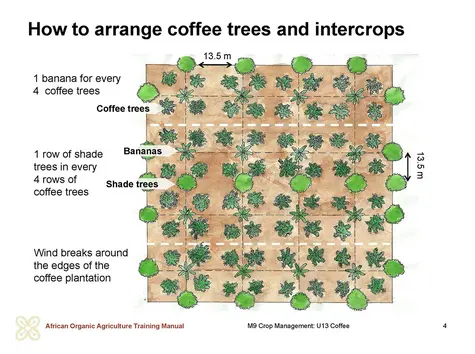
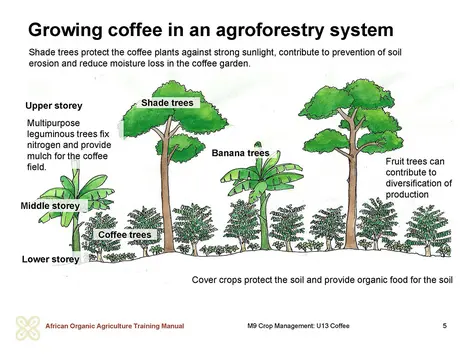
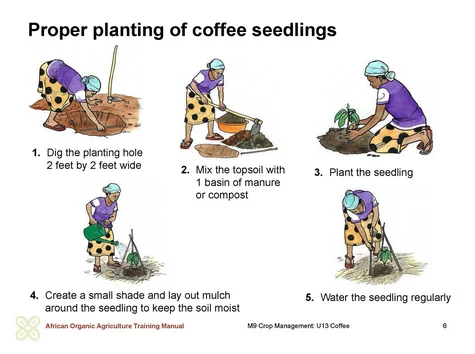
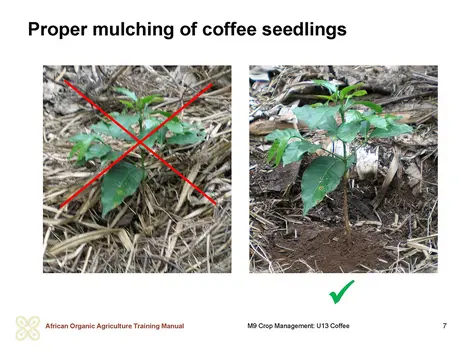
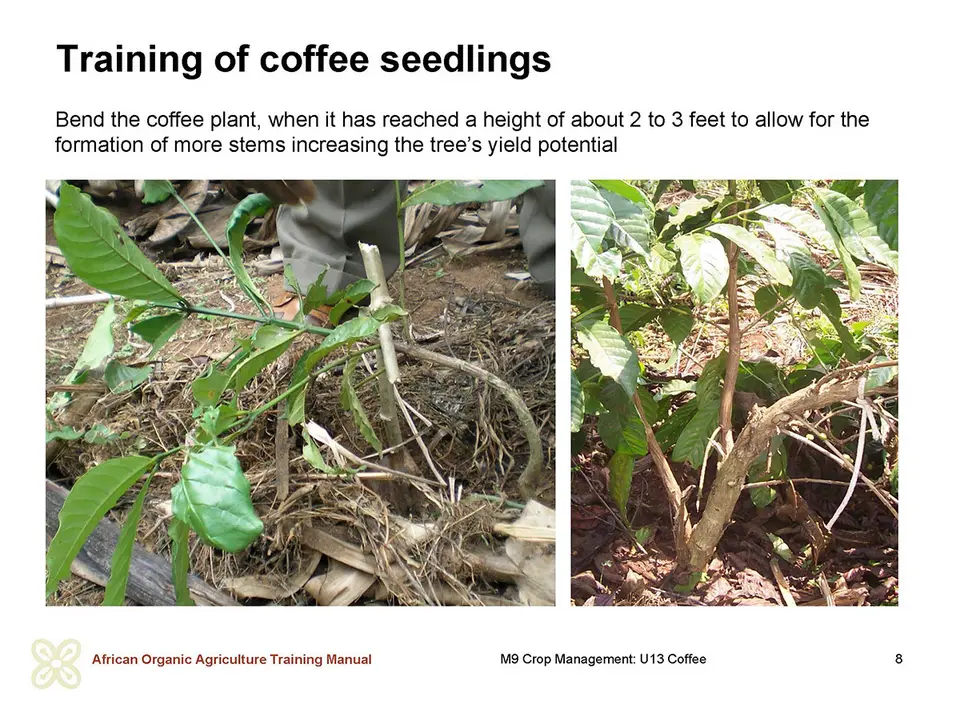
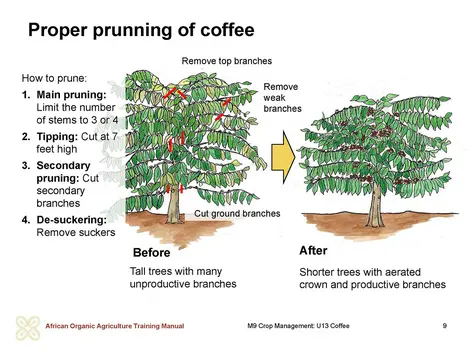

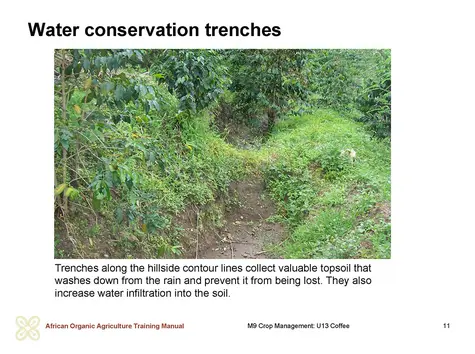
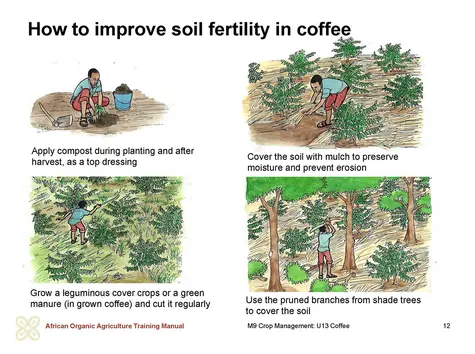
 tap and then scroll down to the Add to Home Screen command.
tap and then scroll down to the Add to Home Screen command.